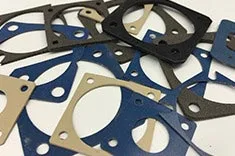EMI Shielding Products
- Custom Gasket Fabrication
- Connector Gaskets
- Bonded O Ring
- Custom Gaskets
- Conduct-O-Knit Knitted Wire Mesh
- Conduct-O-Seal Combo Gasket
- Conduct-O-Elastomer
- Conduct-O-Seal Oriented Wire in Silicone Gasket Material
- Conduct-O-Mesh Tape
- Conduct-O-Foam
- Conduct-O-Bond
- Optical Filters For Electronic Displays
- Shielded Vent Panels
- 300 Series
What Are the Most Common Options for Shielding EMI Materials?
 Individuals have many options when it comes to EMI materials for shielding. It is important to recognize that no two systems or electronics are the same, and as a result, custom EMI shielding is appropriate for the optimal performance of electronic devices. Innovations within the silicone compounding industry allow engineers to meet the strong demands of shielding requirements and product specifications. Nickel graphite, for instance, is available in three different durometers/Shore A (30, 40, & 50). These silicone gaskets are soft enough to be used as enclosure gaskets. Higher durometer shielding elastomers often use fluorosilicone as their base elastomer, which is strong against chemicals and resisting fuels. Fluorosilicone compounds are used in Durham that range between 50 and 80. This type of durometer it's best for gaskets made of harder materials.
Individuals have many options when it comes to EMI materials for shielding. It is important to recognize that no two systems or electronics are the same, and as a result, custom EMI shielding is appropriate for the optimal performance of electronic devices. Innovations within the silicone compounding industry allow engineers to meet the strong demands of shielding requirements and product specifications. Nickel graphite, for instance, is available in three different durometers/Shore A (30, 40, & 50). These silicone gaskets are soft enough to be used as enclosure gaskets. Higher durometer shielding elastomers often use fluorosilicone as their base elastomer, which is strong against chemicals and resisting fuels. Fluorosilicone compounds are used in Durham that range between 50 and 80. This type of durometer it's best for gaskets made of harder materials.
Older shielding elastomers often did not contain enough metal filler to ensure the most effective possible EMI shielding. Today, EMI shielding can more reliably ensure effective electrical conductivity. New, conductive silicones are reliable and cost-effective.
Shielding EMI
Some shielding EMI gasket applications require reinforcement through added strength, which is impossible through many high durometer nickel-graphite silicones. In instances like this, 65-durometer elastomers are used with internal nickel-coated mesh. It is also possible to have lower-durometer silicones reinforced with layers of conductive fabrics (adding strength and conductivity). Doing this greatly reduces the odds of tearing during EMI gasket fabrication.
Related Reading


